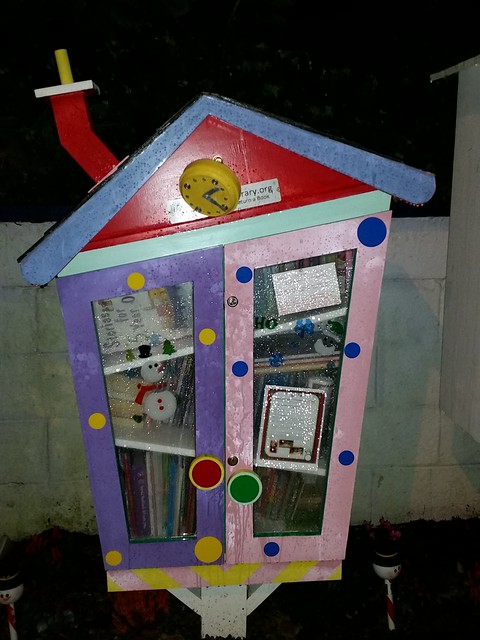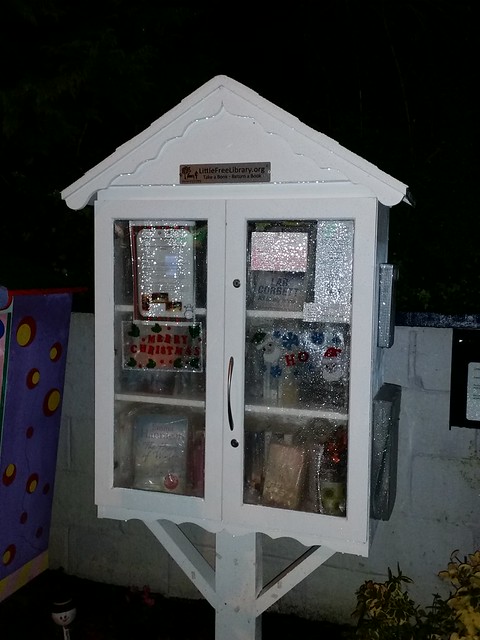* This is part of a series on the 20th Anniversary of the fall of the Berlin Wall – and my attempt to document the events of the weekend, where 20 years before, a peaceful revolution brought about a big change which helped to end the cold war, and bring about a new Europe.
Many more of the events are in the full flickr set here. *
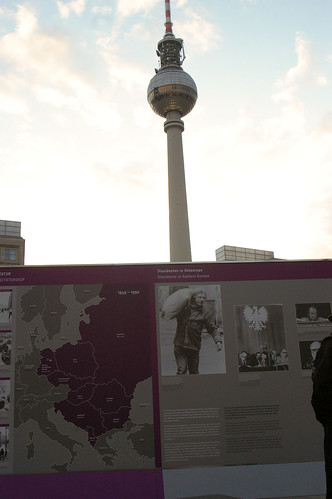
East v/s West Map W/ TV tower in the background, and a photo of one of the more famous Dissidents in Eastern Europe – Lech Walesa of Poland
As many of you know, this week is the 20th Anniversary of the fall of the Berlin Wall. As a part of the celebrations, the city put up a huge display on the protests and documentation on the “behind the scenes” movements that brought down not only the Berlin Wall, but most of “eastern block” communism as well. It’s an Outside “museum” and information type display, and very powerful. Why? because the entire display is on the main “protest grounds”, in the shadow of the TV tower.
The entire display is a series of 7 or 8 long panels in the shape of the old “concrete blocks” that held the wall together. It takes several hours to go through, but thus far has gotten lots of attention from locals and tourists alike.
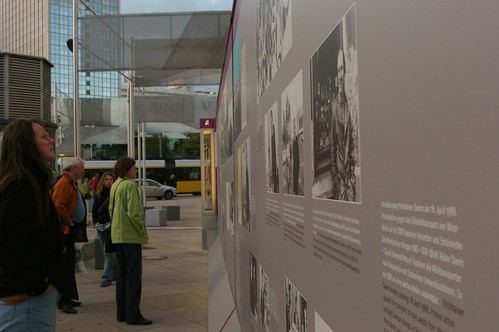
As you walk along, you learn about the history of Germany After World War 2 and how the city was divided. You also get to see photographs of the devistated state (a 1989 photograph of Potsdam’s famed Dutch section – never repaired by the DDR government-below) of Germany just after the war – and how much of it was questionable as far as saving goes:

In addition, you see old photographs of the Berlin Wall – as it was (west looking east below) – not just a single wall – but two – divided by a death strip. The photo below is circa 1988 – and near Checkpoint Charlie:
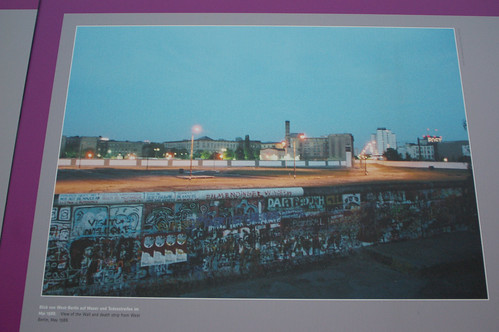 center>
center>
It talks about the movements for change – led by churches and students alike – and shows examples of notebooks, banned / smuggled books, and yes, even invitations to “workshops” on how to achieve Peace.
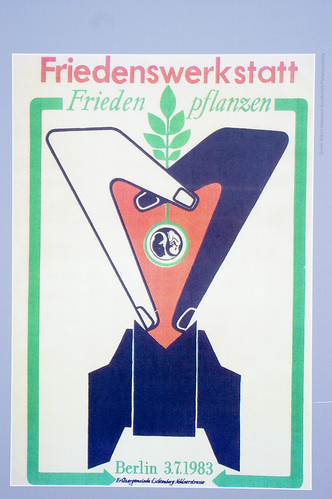
Invitation to the Peace workshop in East Berlin’s Chruch of the Redeemer in July 1983. UP to 3000 people from all over East Germany met up every year at the Berlin Peace workshops. These major events provided UNCENSORED information, and space for public political debates.
In the end, as the 1980’s continued, it talks about how Gorbachev brought about “glasnost” to Russia but there was still no such “openness” here in Germany. It sheds some light on the frustrations of the people in the GDR, and even continues to talk about the support from East German activists and how they encouraged each other – and yes, even those very far away (Tieneman Square, China) – through protests, sit ins, and yes, even flyers distributed at youth clubs like the one below –
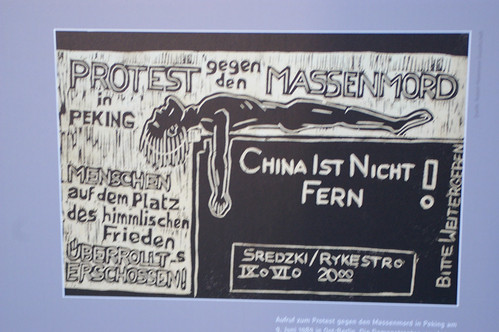
Flyer for a protest against the mass murder in Beijing, 9 of June 1989 in East Berlin. The Demonstrators were immediately arrested, interrogated and fined. This flyer was distributed at a local youth club – the manager of the club was dismissed the next day.
As time went on, the protests grew bigger and bigger:
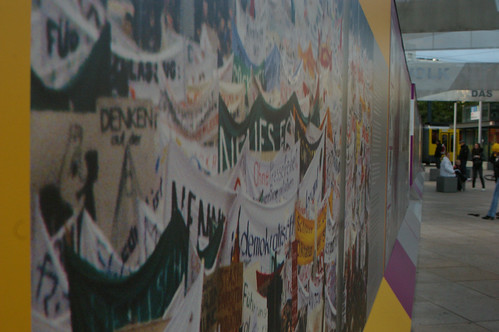
Until on the night of November 9th, 1989, crowds stormed the Berlin wall, climbed on top and around it and began chisseling it apart. In the “wee hours” of the morning, the wall was finally broken through – to great celebrations.
I was in middle school at the time – and lucky enough to be going to “high tech high”, where my school let us watch CNN news every morning for 15 minutes. I remember going in to school, and the teachers not saying a word, but instead of just the 15 minutes – letting us watch through the morning as we had eagerly watched the weeks prior – and getting to see the first handshakes through the wall and the extasy on the faces live. I know for me, it filled me with elation and hope – because it was a peaceful protest that had brought about change.
20 years on, I have the privledge of living in what was “west germany” and working in what was “east germany” with many wonderful colleagues who grew up on both sides of the wall. To them, it was a normal part of their lives – and a “homeland” and way of life that many have felt a loss deeper than we can imagine. When you ask them about it, they have fond memories of the DDR and the way things “were”. It’s a homeland that is lost, and yet a freedom that they have gained (some more eagerly than others) that they hope is never again taken away. Culturally, I think that there is a “guilt” over WW2, and yet a knowledge that Berlin – as a city, and Germany – as a Nation is still healing. However, they are continuing to do so, and progress has been made every day.
I guess, to those who missed the live tv coverage and/or weren’t there -the spray painted graffiti just outside the “open air” museum at Alexanderplatz really says it all. One night, they went to bed living in a “communist” DDR, and when they woke up the next morning, they lived in a nation no longer divided by a wall – a nation that took back all her people with but promises of Democracy, dreams that can be fullfilled, and hopes that can be realized. For those from the DDR, it really was a matter of “wake up and Change!”
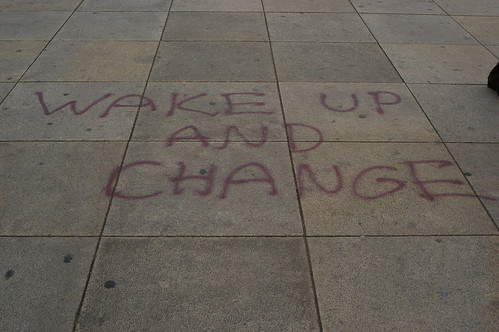
PS. On a personal note – Tonight is my first “official” celebration – U2 is putting on a free concert at the Brandenburg Gate – and I have tickets. An Irish rock band, they had relocated to Germany – just at the time the wall fell, seeking a new sound. That sound became the album “Achtung Baby”. The concert is free in celebration of the Wall’s Fall, and being flimed, live, for the MTV european music awards – held in Berlin later that night. I’m sure I’ll have plenty of photographs and more to discuss this weekend.
